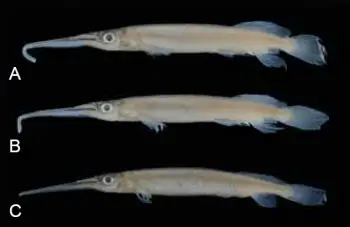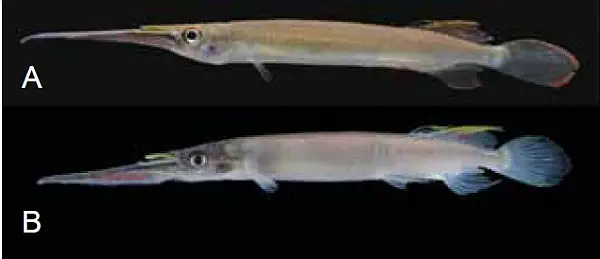New halfbeaks from Borneo
Three new halfbeak species of the genus Hemirhamphodon have been described in ‘The Raffles Bulletin of Zoology’.
Alongside Dermogenys and Nomorhamphus this is one of three genera in the family Zenarchopteridae in which members practice internal fertilisation and viviparity (livebearing) with the exception of H. tengah which is oviparous.
Hemirhamphodon sesamum is known only from the Batulicin and Cantung river basins in South Kalimantan province, Indonesian Borneo where it was collected from small, flowing streams containing clear water.
Sympatric fish species included Hampala macrolepidota, Osteochilus cf. waandersii, Rasbora dies, R. elegans, R. lacrimula, ‘Puntius‘ anchisporus, ‘P.‘ banksi, Balitoropsis stephensoni, Homalopteroides nebulosus, Nemacheilus cf. spiniferus, Betta edithae, Channa lucius, and Macrognathus maculatus.
It can be told apart differs from all congeners by the following combination of characters: dorsal-fin with melanophores in two distinct sizes – in live males first 6-7 rays with yellow suffused throughout the distal one-third and interradial membrane, with iridescent red margin, intense black pigments on the mid-section of interradial membrane between first 3 rays, red pigmentation on the mid-section of interradial membrane between rays 6-11; remainder of fin hyaline; in live females first 6-7 rays suffused with pale yellow, with iridescent red margin; small patches of black pigments on the middle section of the interradial membrane of first 6-7 rays; remainder of fin hyaline; males with unique dorsal fin morphology – distal portions of first 6-7 rays elongated, free of interradial membrane, and projected into filaments up to twice the depth of the dorsal fin; adpressed fin rays reaching beyond caudal-fin base; unique colouration on lower jaw; in live males upper jaw with corresponding portion of lower jaw yellow; dorsal surface of exposed lower jaw bluish, dermal flange below middle section of lower jaw bright red with blue lower margin, tip of lower jaw to region below upper jaw red; dermal flange of lower jaw with distinct black ventral margin from tip to region directly below eye; in live females colour pattern similar but colours are comparatively less intense; males with the fourth anal-fin ray distinctly enlarged, and third, fourth and eighth anal-fin rays branched; females with third and fourth anal-fin rays branched; pelvic-fin origin anterior to dorsal-fin origin; dorsal-fin rays 13 or 14 (mode 13).
Hemirhamphodon byssus was formerly considered to be conspecific with H. kuekenthali and it differs from other genus members as follows: dorsal fin with melanophores in two sizes – in males and females larger than 30 mm SL interradial membranes on the anterior half of the dorsal fin with large and intense melanophores throughout fin depth, appearing as thin black streaks; males larger than 50 mm SL with unique dorsal fin morphology – distal portions of first 6 to 7 rays elongated, free of interradial membrane, projected into filaments up to four times the depth of the dorsal fin; adpressed fin rays reaching middle of caudal-fin; males with an enlarged posterior projection on the fourth anal-fin ray, with third, fourth and eighth anal-fin rays branched; females with third, fourth and eighth anal-fin rays branched; pelvic-fin origin anterior to dorsal-fin origin; dorsal-fin rays 13 to 14 (mode 14).
It inhabits lowland forest and peat swamps in southern Sarawak, Malaysian Borneo and is currently known from Sematan, Lundu, Bau, Batu Kawa, Matang, Bako, Serian, Balai Ringin, Gedong and Sri Aman.
The third species inhabits flowing streams of the lower Mahakam river basin in East Kalimantan and has been named H. kecil.
It is distinguished from congeners by the following characters: absence of discernible markings on body and fins, except dorsal portion of caudal fin base which possesses sparse black pigmentation in both males and females and the submargin of the dorsal fin is suffused with black pigments; small adult size, up to 41 mm SL (only H. tengah is smaller); adult sizes for male and female similar (as in H. tengah), other congeners with males up to 50% larger than females; males with an enlarged posterior projection on the fourth anal-fin ray, with third, fourth, sixth and eighth anal-fin rays branched; females with third, fourth and eighth anal-fin rays branched; pelvic-fin origin anterior to dorsal-fin origin; dorsal-fin rays 14 to 15 (mode 14).
The study also features a key to the genus and some additional notes regarding the poorly-known H. phaisoma.
For further information download the full, open access paper: Tan, H. H., and K. K. P. Lim, 2013. Three new species of freshwater halfbeaks (Teleostei: Zenarchopteridae: Hemirhamphodon) from Borneo. The Raffles Bulletin of Zoology 61(2): 735-747
Category: New Species, News | Tags: Borneo, fish, fishkeeping, halfbeak, Hemirhamphodon, Raffles | Comment »





Product reviewers wanted
Hello! Very much interested in writing for you, please include me in the info. Thank you for the opportunity!
6th Sep 2020
Product reviewers wanted
I would be interested in reviewing products. Before retiring I was a technical writer and managed a Quality Management Program.
30th Aug 2020
Product reviewers wanted
I'm interested and can write reviews from the perspective of someone new to the hobby. I'm only 3-4 months in, but hopefully I can help someone that's...
23rd Aug 2020
Product reviewers wanted
I’m interested in doing this if there is still availability, it sounds like fun! Thanks
19th Aug 2020
Barbodes semifasciolatus – Golden Barb* (Barbus sachsii, Puntius schuberti)
I simply had a question (please forgive if this is not allowed, I read the FAQ but I was not sure). I was wondering if there is any evidence of offsp...
12th Aug 2020